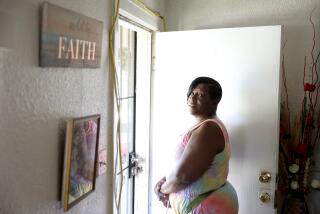Asthmatics’ Facility May Have to Close
- Share via
Sunair Home for Asthmatic Children in Tujunga, the only live-in rehabilitation facility of its kind in California, may close within a month, officials at the home have said last week.
A change in rules governing county funding appears likely to reduce the number of patients to just three by the end of the month, forcing the 47-year-old home to close, spokesman Robert Garon said.
Sunair’s population has decreased dramatically since March, when county officials announced they would only pay for two months of treatment per patient at the home, rather than six months as before.
When the holiday recess ends Monday, Garon said, 12 children are expected to be enrolled. By the end of the month, all but three of those are scheduled to be discharged as funding runs out.
County officials, although defending their decision to reduce funding to the home, agreed that its closing would be a loss to statewide efforts to treat children afflicted with asthma, a chronic breathing disorder.
Both county and Sunair officials said the home might survive if it branched out to treat other types of patients such as diabetics and epileptics. But they said that, although they are studying such a move, it is not clear whether alternative programs could be set up quickly enough or would be successful.
Sunair, a 39-bed, 19-acre home operated by a private, nonprofit corporation, offers a six-month live-in rehabilitation program for asthmatic children ages 6 to 17. Patients are taught to control their asthma through medication and exercises aimed at restraining their emotions.
Dr. Dwight Lee, assistant medical director for children’s services with the Los Angeles County Health Department, which tightened the rules on funding, said Sunair occupies a “small but unique niche in California” in the treatment of asthma.
Lee said Sunair is needed for the “small minority of asthmatic children in crisis who need to break away from their home environment for a short time. Sunair has filled that role quite well, and I know of no other facility like it.”
He said most asthmatic children are treated by physicians through office visits, supplemented by brief stays in an acute-care hospital.
About 80% of Sunair’s $1.2-million annual budget comes from public agencies, chiefly the state. The state funds are distributed by the county Health Department.
The remaining 20% of Sunair’s budget comes from private contributions and foundation grants.
State Revenues Decline
Betty Porche, director of the county’s California Childrens Services program, said reduced funding for Sunair was part of an overall cutback in medical expenditures prompted by a decline in state revenue.
“After more than two years of review and discussion,” she said, “we decided that 60 days was adequate time for almost all children to obtain full benefit from the Sunair program,” she said.
Porche said county officials concluded that benefits derived from the final four months at Sunair are not usually medical “but have to do with keeping the child in a calm environment for a longer time, or to avoid disrupting the child’s schoolwork.”
Garon disagreed sharply, saying county officials had failed to take into account “the fact that Sunair’s goal is to make the child self-sufficient for life, not just to stabilize the child’s asthma.”
He said that hospitals are usually successful in stabilizing a child’s asthma, but that Sunair goes a step further by teaching a child techniques for “stabilizing his asthma in the community, not just in a hospital-like setting.”
Garon said Sunair, which was founded by local businessmen in 1937, subsisted largely on private donations until the mid-1970s, when it began receiving state aid.
He said many donors have quit giving to the home “because they think we’re all taken care of now that we get public funding.”
More to Read
Sign up for Essential California
The most important California stories and recommendations in your inbox every morning.
You may occasionally receive promotional content from the Los Angeles Times.













